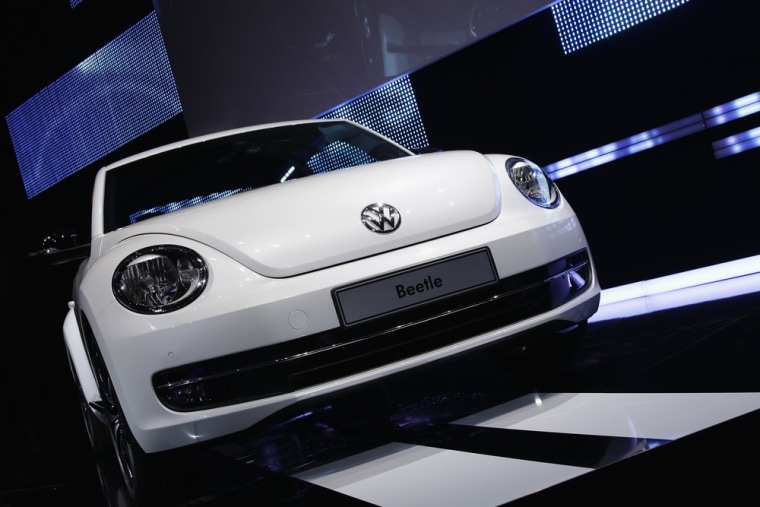Will American motorists — never mind those in Germany and the rest of Europe — take to the latest generation of the Volkswagen Beetle?
More than seven decades after the launch of the original “people’s car,” an all-new Bug is finally rolling into showrooms — or perhaps that should read the “Newer” Beetle, as VW’s new Bug replaces the so-called New Beetle, which the German automaker launched a decade ago to general indifference in much of the world.
That was especially true in Germany, where motorists saw the retro-mobile as an uncomfortable reminder of the austere days following the end of World War II. It was cheap transportation for a devastated nation looking for more than bicycles, but by the turn of the new Millennium it was no longer chic. In the U.S., meanwhile, the New Beetle developed a strong but short-lived cult. Demand for the car fell rapidly as the round design became derided as a “chick car.”
With the introduction of the third-generation Beetle, Volkswagen designers have adopted what they describe as “heritage” styling, adopting the extended snout of the original car while giving the 2012 coupe all the creature comforts and safety features buyers of the original Beetle could have only dreamed of.
Designed by the legendary Ferdinand Porsche — who went on to lend his name and talents to the Stuttgart-based sports car company — the Beetle first rolled into showrooms in the days immediately before World War II. Only a small number made it to market before the start of hostilities and once the war ended barely a few survived. One was even found in the rubble of the carmaker’s plant, in Wolfsburg, Germany, by a British military detachment that was charged with helping revive the Teutonic economy.
Ultimately, the design remained in production for 75 years, the last of approximately 21 million Beetles rolling off a VW assembly line in Mexico in 2003.
The iconic design was, by then, outdated and unable to meet increasingly stringent global safety and emissions standards. So VW rolled out the New Beetle, designed by a team led by J Mays, now the chief stylist at Ford. Rounder and more compact than the original, the replacement coupe caught on fast — but burned out just as quickly. Sales in the U.S. peaked at 83,434 in 1999, but by 2009 demand had slumped to just 14,085.
Even at its best, the New Beetle generated sales in the U.S. of barely a quarter the 350,000 the original Beetle saw at its peak. And the car fared even more poorly abroad.
Yet when pressed to simply walk away from the car and concede defeat, VW officials said, “Nein.”
“It is, for us, an iconic part of our history,” explained Rainer Michael, Volkswagen’s vice president of product and marketing.
The challenge was coming up with a new design that could broaden the New Beetle’s appeal — both by drawing more men to the car and by expanding the global market.
Designers carefully examined the original Beetle and took from it the more sporty cues originally penned by Porsche three quarters of a century ago. The 2012 Beetle’s snout is longer, and rather than having a “living room-like cabin,” the new version of the car is “more like sitting in a sports car,” noted Andreas Valbuena, the Beetle program manager.
Indeed, there is a surprising degree of similarity between the reborn Bug — which is lower, longer and wider than the car it replaces — and early versions of the Porsche 911.
Designers have trod cautiously, reviving the car’s classic details, such as the “kaeferbach,” or second glove box, while struggling to avoid being accused of being too retro — a dreaded label in the auto industry these days.
Beyond its design, the 2012 Volkswagen Beetle is decidedly modern, with a full complement of airbags and other state-of-the-art safety features. It is quick, with optional 19-inch wheels that underscore its sporty intentions. And there are any number of creature comforts and convenience features, including a large LCD navigation screen and even a music-blasting audio system developed in cooperation with that icon of American rock-and-roll, Fender.
Valbuena is confident the new model will no longer be dismissed as a “girl’s car,” and the new design certainly drew plenty of stares and positive waves during a circuitous drive through in Berlin recently.
The automotive world has changed dramatically since the original Beetle ruled the road. At one point the car didn’t even have a name (it was marketed as simply the “Volkswagen.”) Today, the brand’s showrooms are filled with an ever-expanding line-up of products. And the Beetle will plunge into a pool filled with competitors’ competent alternatives.
A key to maintaining demand for the Beetle after the initial attraction of the new car wears off will be to steadily roll out new variants, explained Beetle manager Valbuena. A turbo and a convertible package are already in the works and other alternatives will follow, he hinted.
“Something to keep it fresh and new will be following every year,” Valbuena promised.
Can the newest Beetle match the success of the original? That means a 75-year lifespan and 21 million cars — or sales of 350,000 a year — in the U.S.
Not a chance, VW officials quickly concede. In fact, demand will likely lag more mainstream models, such as the Golf, Jetta and Passat, acknowledged Jonathan Browning, head of Volkswagen Group of America.
But VW is betting that the little coupe will provide the sort of iconic face to the brand that few other carmakers have. And that, company officials are betting, will be the Beetle’s biggest contribution going forward.
